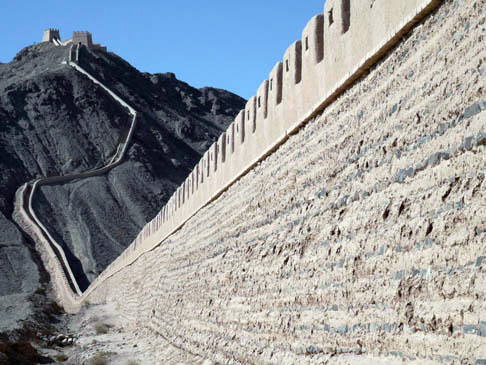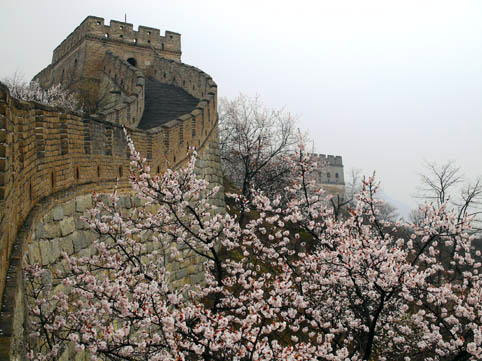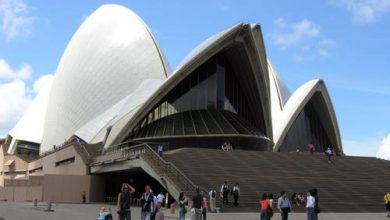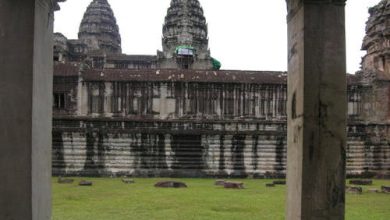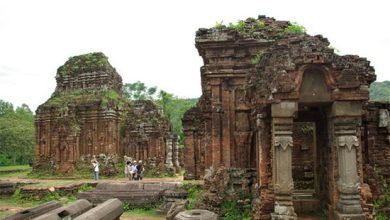The Great Wall
In c. 220 B.C., under Qin Shi Huang, sections of earlier fortifications were joined together to form a united defence system against invasions from the north. Construction continued up to the Ming dynasty (1368–1644), when the Great Wall became the world’s largest military structure. Its historic and strategic importance is matched only by its architectural significance.
Outstanding Universal Value
Brief synthesis
The Great Wall was continuously built from the 3rd century BC to the 17th century AD on the northern border of the country as the great military defence project of successive Chinese Empires, with a total length of more than 20,000 kilometers. The Great Wall begins in the east at Shanhaiguan in Hebei province and ends at Jiayuguan in Gansu province to the west. Its main body consists of walls, horse tracks, watch towers, and shelters on the wall, and includes fortresses and passes along the Wall.
The Great Wall reflects collision and exchanges between agricultural civilizations and nomadic civilizations in ancient China. It provides significant physical evidence of the far-sighted political strategic thinking and mighty military and national defence forces of central empires in ancient China, and is an outstanding example of the superb military architecture, technology and art of ancient China. It embodies unparalleled significance as the national symbol for safeguarding the security of the country and its people.
Criterion (i): The Great Wall of the Ming is, not only because of the ambitious character of the undertaking but also the perfection of its construction, an absolute masterpiece. The only work built by human hands on this planet that can be seen from the moon, the Wall constitutes, on the vast scale of a continent, a perfect example of architecture integrated into the landscape.
Criterion (ii): During the Chunqiu period, the Chinese imposed their models of construction and organization of space in building the defence works along the northern frontier. The spread of Sinicism was accentuated by the population transfers necessitated by the Great Wall.
Criterion (iii): That the Great Wall bear exceptional testimony to the civilizations of ancient China is illustrated as much by the rammed-earth sections of fortifications dating from the Western Han that are conserved in the Gansu province as by the admirable and universally acclaimed masonry of the Ming period.
Criterion (iv): This complex and diachronic cultural property is an outstanding and unique example of a military architectural ensemble which served a single strategic purpose for 2000 years, but whose construction history illustrates successive advances in defence techniques and adaptation to changing political contexts.
Criterion (vi): The Great Wall has an incomparable symbolic significance in the history of China. Its purpose was to protect China from outside aggression, but also to preserve its culture from the customs of foreign barbarians. Because its construction implied suffering, it is one of the essential references in Chinese literature, being found in works like the “Soldier’s Ballad” of Tch’en Lin (c. 200 A.D.) or the poems of Tu Fu (712-770) and the popular novels of the Ming period.
Integrity
The Great Wall integrally preserves all the material and spiritual elements and historical and cultural information that carry its outstanding universal value. The complete route of the Great Wall over 20,000 kilometers, as well as elements constructed in different historical periods which constitute the complicated defence system of the property, including walls, fortresses, passes and beacon towers, have been preserved to the present day. The building methods of the Great Wall in different times and places have been integrally maintained, while the unparalleled national and cultural significance of the Great Wall to China is still recognised today. The visual integrity of the Wall at Badaling has been impacted negatively by construction of tourist facilities and a cable car.
Authenticity
The existing elements of the Great Wall retain their original location, material, form, technology and structure. The original layout and composition of various constituents of the Great Wall defence system are maintained, while the perfect integration of the Great Wall with the topography, to form a meandering landscape feature, and the military concepts it embodies have all been authentically preserved. The authenticity of the setting of the Great Wall is vulnerable to construction of inappropriate tourism facilities.
Protection and management requirements
The various components of the Great Wall have all been listed as state or provincial priority protected sites under the Law of the People’s Republic of China on the Protection of Cultural Relics. The Regulations on the Protection of the Great Wall promulgated in 2006 is the specific legal document for the conservation and management of the Great Wall. The series of Great Wall Conservation Plans, which is being constantly extended and improved and covers various levels from master plan to provincial plans and specific plans, is an important guarantee of the comprehensive conservation and management of the Great Wall. China’s national administration on cultural heritage, and provincial cultural heritage administrations where sections of the Great Wall are located, are responsible for guiding the local governments on the implementation of conservation and management measures for the Great Wall.
The Outstanding Universal Value of the Great Wall and all its attributes must be protected as a whole, so as to fulfill authentic, integral and permanent preservation of the property. To this end, considering the characteristics of the Great Wall, including its massive scale, transprovincial distribution and complicated conditions for its protection and conservation, management procedures and regulations, conservation interventions for the original fabric and setting, and tourism management shall be more systematic, scientific, classified, and prioritized. An efficient comprehensive management system, as well as specific conservation measures for the original fabric and setting will be established, while a harmonious relationship featuring sustainable development between heritage protection and social economy and culture can be formed. Meanwhile, the study and dissemination of the rich connotation of the property’s Outstanding Universal Value shall be enhanced, so as to fully and sustainably realize the social and cultural benefits of the Great Wall.
Long Description
Known to the Chinese as the ‘Long Wall of Ten Thousand Li’, the formidable defensive structures built to ward off invasion of the Celestial Empire by barbarians is called the Great Wall or the Wall of China by Europeans. The principle of these extraordinary fortifications goes back to the Chunqiu period (722-481 BC) and to the Warring States period (453-221 BC).
The construction of certain walls can be explained by feudal conflicts, such as that built by the Wei in 408 BC to defend their kingdom against the Qin. Its vestiges, conserved in the centre of China, antedate by many years the walls built by the Kingdoms of Qin, Zhao and Yan against the northern barbarians around 300 BC. Beginning in 220 BC, Qin Shi Huang, the founder of the Empire of the Ten Thousand Generations, undertook to restore and link up the separate sections of the Great Wall which had been built in the 3rd century BC, or perhaps even earlier, and which stretched from the region of the Ordos to Manchuria.
Towards the west, he had extended the fortifications, the first cohesive defence system of which significant vestiges still remain in the valley of the Huanghe all the way to Lanzhou shortly before the accession of the Han dynasty (206 BC). During their reign the Great Wall was extended even further, and under the emperor Wudi (140-87 BC) it spanned approximately 6,000 km between Dunhuang in the west and the Bohai Sea in the east. The danger of incursion along the northern Chinese border by the federated Mongols, Turks and Tunguz of the Empire of the Xiongnu, the first empire of the steppes, made a defence policy more necessary than ever. After the downfall of the Han dynasty (AD 220), the Great Wall entered its medieval phase. Construction and maintenance works were halted; China at that time enjoyed such great military power that the need for a defence policy was no longer felt.
It was the Ming Emperors (1368-1644) who, after the long period of conflict that ended with the expulsion of the Mongols, revived the tradition begun by Qin Shi Huang. During the Ming dynasty, 5,650 km of wall were built. To defend the northern frontier, the Wall was divided into nine Zhen, military districts rather than garrisons. At strategic points, fortresses were built to defend the towns, passes, or fords. The passageways running along the top of the wall made it possible to move troops rapidly and for imperial couriers to travel. Two symbolic monuments still proudly stand at either end of the wall – the First Door under Heaven at Shanhaiguan, located at the wall’s eastern end, and the Last Door under Heaven at Jiayuguan, which, as part of the fortress entirely restored after 1949, marks its north-western end.
This complex and diachronic cultural property is an outstanding and unique example of a military architectural ensemble which served a single strategic purpose for 2,000 years, but whose construction history illustrates successive advances in defence techniques and adaptation to changing political contexts. The purpose of The Great Wall was to protect China from outside aggression, but also to preserve its culture from the customs of foreign barbarians. Because its construction implied suffering, it is one of the essential references in Chinese literature.
The Great Wall of the Ming is, not only because of the ambitious character of the undertaking but also the perfection of its construction, a masterpiece. The wall constitutes, on the vast scale of a continent, a perfect example of architecture integrated into the landscape. During the Chunqiu period, the Chinese imposed their models of construction and organization of space in building the defence works along the northern frontier. The spread of Sinicism was accentuated by the population transfers necessitated by the Great Wall.
That the great walls bear exceptional testimony to the civilizations of ancient China is illustrated as much by the tamped-earth sections of fortifications dating from the Western Han that are conserved in Gansu Province as by the admirable and universally acclaimed masonry of the Ming period.
Source: UNESCO/CLT/WHC

